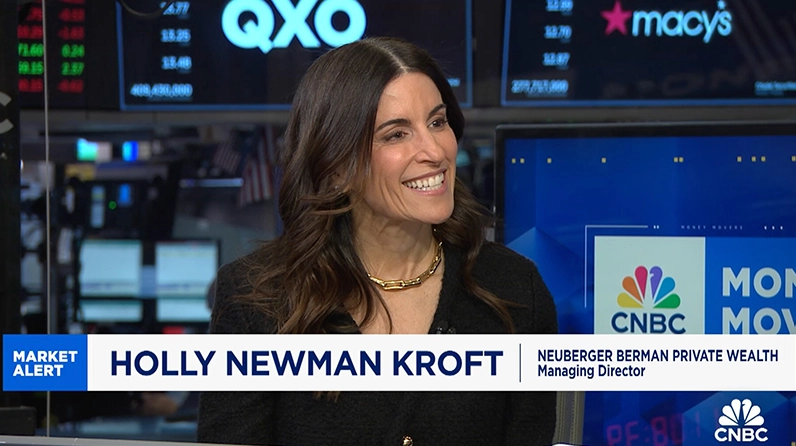

With robust employment levels and strong consumer and corporate balance sheets along with the potential for tariff rates to be negotiated lower, we believe that the U.S. will avoid a recession and a protracted economic deceleration.
March’s non-farm payrolls release came in well above consensus expectations, up +228k versus the estimate for +140k. Driving the print were notable gains in health care (+54k), social assistance (+24k), retail trade (+24k), transportation & warehousing (+23k), and government (+19k), although admittedly that was led by state and local hiring as DOGE efforts are starting to have an impact on data. Revisions to January and February payrolls netted to a decrease of -48k versus the previously reported prints.
Wage growth came in on target, up +0.3% month-over-month and +3.8% year-over-year, continuing the cooling trend in 2025.Average hours worked were steady at 34.2. Employed persons rose by +201k while unemployed persons rose by only +31k. The participation rate rebounded back to 62.5% from 62.4%, helping to drive the unemployment rate higher to 4.2%. The caveat to the relative strength of this report is that it reflects the time period ahead of the now announced tariffs; it also reflects a reversal of an outsized impact from poor weather in the prior two reports.
As for the market reaction, equity markets are lower as are Treasury yields as tariffs remain squarely in the crosshairs for investors. In fact, despite the stronger than expected print, markets are still pricing in four rate cuts by October, reflecting lower growth, higher inflation, and higher recession risks on the back of Wednesday’s tariffs announcements. This might prove difficult for the Fed to effect given the likely upward pressure on prices; more color may come from the Fed in the coming days.
To that end, we have widened our range of outcomes for both U.S. GDP growth and inflation. Coming into this year, we had expected +2.3% growth and lowered that to +1.7% on the back of initial tariff announcements. With this week’s news, we estimate that U.S. GDP, if tariffs remain in place at currently announced levels, could be at or slightly below +1% in 2025, with some downside risk on escalation. We also believe that inflation could be +3.5% at the end of 2025, higher than our initial forecast of +3.1% after the first round of tariffs and +2.6% in our year end outlook.
Given the strong current starting point for the U.S. economy, however, with robust employment levels and strong consumer and corporate balance sheets, as well as the potential for tariff rates to be negotiated lower as pro-growth fiscal policy comes into focus, we believe that the U.S. will avoid a recession and a protracted economic deceleration. We expect uncertainty to ease as we move closer to the second half of the year but acknowledge that volatility may persist in the near term. This may create attractive levels for adding to equity exposure, particularly for clients with outsized cash positions. We remain conscious of the balance between risk and opportunity in this environment, and we will continue to assess this balance as we allocate at the asset class, sector, and company level with the overarching goal to align portfolios with your long-term goals.


VIDEO
Holly Newman Kroft Discussed Market Uncertainty on CNBC

VIDEO
Celebrating Women’s History Month 2025

INSIGHTS
CIO Notebook: Fed Holds Rates Steady but Projections Reflect Policy Uncertainty

INSIGHTS
Private Equity in Perspective: Navigating Extremes and Unlocking Long-Term Value

INSIGHTS
CIO Notebook: Cooler Inflation Calms Nerves but Tariffs Still Loom Large

Accolades
Our Advisors Ranked in “Barron’s Top 1,200 Financial Advisors” List for 2025

INSIGHTS
CIO Notebook: Light U.S. Payrolls Close Out a Noisy Week
MARKET COMMENTARY
Trade Debates While Markets Rotate
INSIGHTS
U.S. Tariffs Hit Markets as Growth Questions Emerge
VIDEO
Holly Newman Kroft Joined CNBC to Discuss Market Outlook
Accolades
Forbes | SHOOK 2025 Top Women Wealth Advisors
INSIGHTS
CIO Notebook: Hotter Inflation Creates Doubt for Investors
INSIGHTS
CIO Notebook: January Payrolls Light but U.S. Labor Market Still Strong
IMPORTANT INFORMATION:
This material is provided for informational purposes only and nothing herein constitutes investment, legal, accounting or tax advice, or a recommendation to buy, sell or hold a security. This material is general in nature and is not directed to any category of investors and should not be regarded as individualized, a recommendation, investment advice or a suggestion to engage in or refrain from any investment-related course of action. Any views or opinions expressed may not reflect those of the firm as a whole. Neuberger Berman products and services may not be available in all jurisdictions or to all client types. Diversification does not guarantee profit or protect against loss in declining markets. Investing entails risks, including possible loss of principal. Investments in private equity are speculative and involve a higher degree of risk than more traditional investments. Investments in private equity are intended for sophisticated investors only. Unless otherwise indicated, returns shown reflect reinvestment of dividends and distributions. Indexes are unmanaged and are not available for direct investment. Investing entails risks, including possible loss of principal. Past performance is no guarantee of future results.
Portfolio positioning views expressed herein are those of Neuberger Berman’s Private Wealth Investment Group, which may include those of the Neuberger Berman’s Asset Allocation Committee. Asset allocation and positioning views are based on a hypothetical reference portfolio. The Private Wealth Investment Group analyzes market and economic indicators to develop asset allocation strategies. The Private Wealth Investment Group works in partnership with the Office of the CIO. The Private Wealth Investment Group also consults regularly with portfolio managers and investment officers across the firm. The Asset Allocation Committee is comprised of professionals across multiple disciplines, including equity and fixed income strategists and portfolio managers. The Asset Allocation Committee reviews and sets long-term asset allocation models, establishes preferred near-term tactical asset class allocations and, upon request, reviews asset allocations for large, diversified mandates. Asset Allocation Committee members are polled on asset classes and the positional views are representative of an Asset Allocation Committee consensus. The views of the Asset Allocation Committee and the Private Wealth Investment Group may not reflect the views of the firm as a whole and Neuberger Berman advisers and portfolio managers may take contrary positions to the views of the Asset Allocation Committee or the Private Wealth Investment Group. The Asset Allocation Committee and the Private Wealth Investment Group views do not constitute a prediction or projection of future events or future market behavior. Defensive positioning generally means an underweight bias on allocations to risk assets such as equities and alternatives. Positioning views may change over time without notice and actual client positioning may vary significantly. Discussion of yield characteristics or total returns of different asset classes are for illustrative purposes only. Such asset classes, such as equities and fixed income, may have significantly different overall risk-return characteristics which should be consider before investing.
The information in this material may contain projections, market outlooks or other forward-looking statements regarding future events, including economic, asset class and market outlooks or expectations, and is only current as of the date indicated. There is no assurance that such events, outlook and expectations will be achieved, and actual results may be significantly different than that shown here. The duration and characteristics of past market/economic cycles and market behavior, including any bull/bear markets, is no indication of the duration and characteristics of any current or future be market/economic cycles or behavior. Information on historical observations about asset or sub-asset classes is not intended to represent or predict future events. Historical trends do not imply, forecast or guarantee future results. Information is based on current views and market conditions, which will fluctuate and may be superseded by subsequent market events or for other reasons.
Discussions of any specific sectors and companies are for informational purposes only. This material is not intended as a formal research report and should not be relied upon as a basis for making an investment decision. The firm, its employees and advisory accounts may hold positions of any companies discussed. Nothing herein constitutes a recommendation to buy, sell or hold a security. It should not be assumed that any investments in securities, companies, sectors or markets identified and described were or will be profitable. Investment decisions and the appropriateness of this content should be made based on an investor's individual objectives and circumstances and in consultation with his or her advisors.
Neuberger Berman Investment Advisers LLC is a registered investment adviser.
The “Neuberger Berman” name and logo are registered service marks of Neuberger Berman Group LLC.